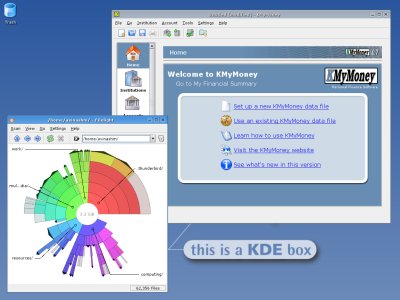
“Il n’y a que les imbeciles qui ne changent jamais d’avis…”
As you can guess by looking at this screenshot, I’m using KDE now (and I’m pleased to tell you that it works perfectly on my Athlon 64 running 64-bits Gentoo Linux). I’ve rediscovered KDE by accident… which I will relate now :
- It all started when I downloaded (out of curiosity) iTunes for Windows which I used to convert my whole CD collection (about 100 CDs) to MP3 format. I was very impressed by iTunes.
- I looked for a similar program running under Linux and I quickly found out about AmaroK.
- AmaroK was a KDE application and, as I was running Gnome, I tried to find something like AmaroK in Gnomeland.
- And I did not succeed… :-)
I quickly realised that there was lots and lots of great KDE applications like AmaroK which I didn’t know about because of my fixation on Gnome and Gtk applications. And I was devastated… So, I decided to give KDE a second chance (as I was a previous KDE 2.0 user before switching to Gnome for some unknown reasons).
KDE has become a (nearly) perfect desktop environment. I run version 3.3.2 and everything is beautiful and snappy.
The standard KDE applications are OK but nothing to shout about. Fortunately, I quickly discovered KDE-Apps where I found some very promising KDE apps which I intend now to test :
- celestia – The free space simulation that lets you explore our universe in three dimensions.
- filelight – graphically represent your filesystem as a set of concentric segmented-rings.
- kdissert – mindmapping-like tool to help [people] to produce complicated documents very quickly and efficiently.
- kdevelop – an easy to use Integrated Development Environment for KDE [which] supports many programming languages.
- kile – an integrated LaTeX environment.
- kmymoney2 – a full-featured replacement for Windows-based finance software.
- lyx – is an advanced open source document processor that encourages an approach to writing based on the structure of your documents, not their appearance.
- scribus – brings award-winning professional DTP to Linux and *nix desktops with a combination of “press-ready” output and new approaches to page layout.
I am also testing blender which is an open source software for 3D modeling, animation, rendering, post-production, interactive creation and playback. Blender is not a KDE application though.
Aha ! Interesting times ahead !
I’ll keep you posted.

Interesting Avinash!
Try kde4, the new one. I suggest enabling your graphic 3d acceleration though, otherwise ou won’t get all the effects!
-> kde.org